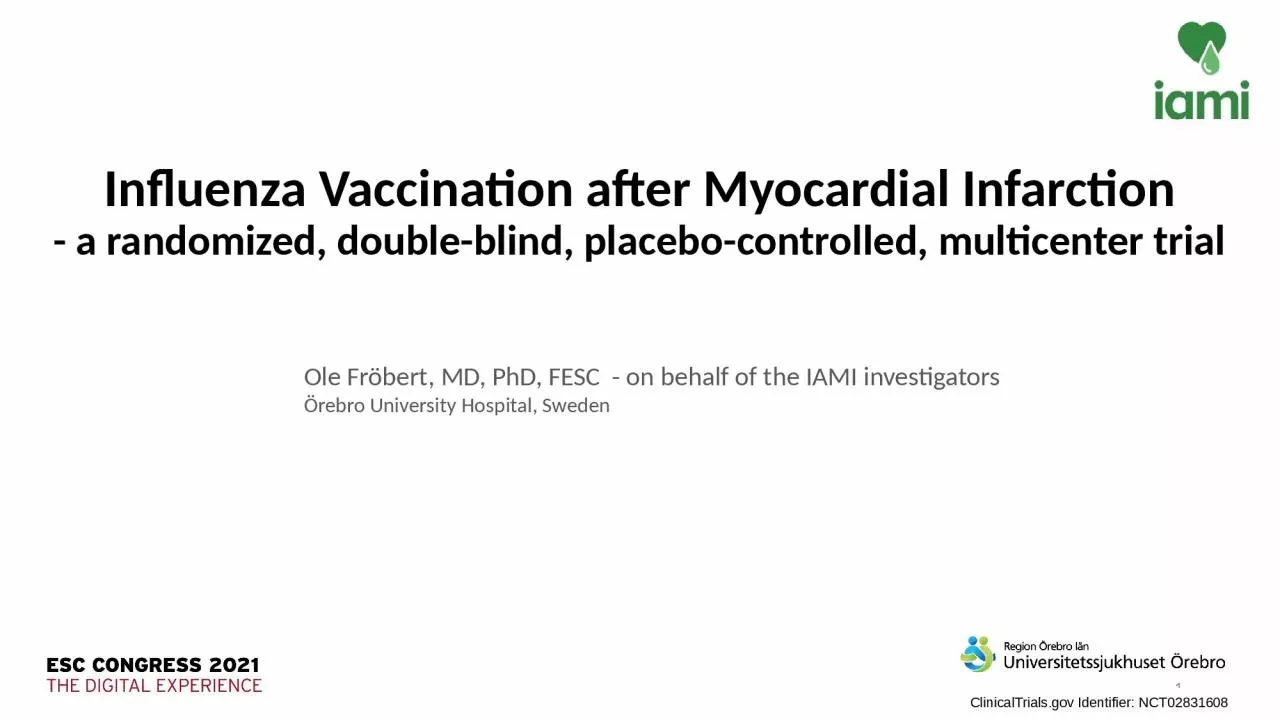

Infarction a randomized doubleblind placebocontrolled multicenter trial 1 ClinicalTrialsgov Identifier NCT02831608 Ole Fröbert MD PhD FESC on behalf of the IAMI investigators ID: 932121
Download Presentation The PPT/PDF document "Influenza Vaccination after Myocardial" is the property of its rightful owner. Permission is granted to download and print the materials on this web site for personal, non-commercial use only, and to display it on your personal computer provided you do not modify the materials and that you retain all copyright notices contained in the materials. By downloading content from our website, you accept the terms of this agreement.
Slide1
Influenza Vaccination after Myocardial
Infarction- a randomized, double-blind, placebo-controlled, multicenter trial
1
ClinicalTrials.gov Identifier: NCT02831608
Ole Fröbert, MD, PhD, FESC
- on behalf of the IAMI investigatorsÖrebro University Hospital, Sweden
Slide2Background
During influenza epidemics more people die from cardiovascular causesNumerous observational studies suggest a protective effect from influenza vaccination on cardiovascular eventsThree, smaller single-center randomized trials support registry findingsInfluenza vaccination carries a class I, level of Evidence B recommendation in both AHA/ACC
and ESC secondary prevention
guidelines but uptake is low and vaccination timing undecided 2
Slide3Influenza and cardiovascular disease
3
Adaptad
from Barnes M, Heart. 2016;102:1953
Influenza virus infection
AtherosclerosisFeverTachycardiaMetabolic demandOxygen saturation
BT
Vasoconstriction
Cytokines
Plaque destabilization
Plaque rupture
Prothrombotic state
AMI
Slide4Outline
Objective. To determine whether influenza vaccination (Vaxigrip, Vaxigrip Tetra, FluQuadri, Sanofi Pasteur) improves clinical outcomes in patients with recent myocardial infarction or high-risk coronary diseaseDesign. Investigator-initiated, international, multicenter, double blind, randomized controlled trialEnrollment. Thirty hospitals across 8 countries, over 4 influenza seasons between 1 Oct
2016 and 1 Mar 2020. Target: 4400 patients
4
Slide5Inclusion and exclusion criteria
Inclusion
criteria
STEMI
Or NSTEMI Or high risk stable patients >75 yCoronary angiography/PCI (not Bangladesh)
Male or female subjects ≥18 yWritten informed consentExclusion criteriaInfluenza vaccine during the current flu seasonIntention to be vaccinated during the current flu seasonIndication for influenza vaccination (as per investigator discretion)Severe allergy to eggs or previous allergic reaction to influenza vaccineFebrile illness or acute, ongoing infection
Endogenic or iatrogenic immunosuppression
Inability to provide informed consent
Age below 18
y
Previous randomization in the
iami
trial
5
Slide6Endpoints
Primary endpoint
Composite
of all-cause death, MI, or stent thrombosis at 12 months
Key secondary endpointsAll-cause deathCardiovascular death
MIStent thrombosisA hierarchical testing approach was pre-specified for the key secondary endpoints (in the order shown) if the primary endpoint was statistically significant6
Slide78 countries and 30 centers
7Sweden Sahlgrenska University Hospital Örebro University Hospital University Hospital
Linköping Centrallasarettet Västerås
Jönköping Hospital Skåne University Hospital Umeå University Hospital Karolinska University Hospital Danderyd University Hospital Uppsala University Hospital Karlstad Central
Hospital Stockholm South General HospitalBangladesh National Institute of CV Diseases
National Heart Foundation Australia Blacktown Hospital SydneyLatvia Pauls Stradins
University Hospital Riga
Norway
LHL-
sykehuset
Gardermoen Oslo
Denmark
Aarhus University
Hospital
Odense University Hospital
Aalborg University Hospital
Rigshospitalet
Bispebjerg
Hospital
Czech
Republic
University Hospital
Kralovske
Vinohrady St. Anne University Hospital
Scotland
Golden Jubilee National Hospital Royal Infirmary of Edinburgh Victoria Hospital,
Kirkcaldy Aberdeen Royal Infirmary University Hospital Hairmyres
Ninewells Hospital, Dundee
Slide8Challenges during the course of the study
Slow recruitment Additional centers and countriesBroader inclusion criteriaEnrichment group: stable high-risk coronary disease (>75y + at least one additional risk factor)Trial halted prematurely on April 7, 2020 by the DSMB due to the COVID-19 pandemic after enrollment of 2571 patients (58% of target) 8
Slide9Enrollment and randomization
9
6696
patients
were
screened2571 were randomized
1290 assigned to vaccine
1281 assigned to placebo
1272 (98.6%) received vaccine
1260 (98.4%) received placebo
21 did not receive study treatment
3 transferred
10 withdrew consent
5 incorrectly randomized
3 other
18 did not receive study treatment
4
transferred
11
withdrew consent
3
incorrectly
randomized
4125 patients were not enrolled
1439 already vaccinated or intending vaccination
1202 patients declined
580 patients not eligible
430 other medical reasons
326 logistical reasons
148 other
Follow-up
12
months
. Final vital status
known
in 99.5%
Slide10Baseline data
10
Slide11Primary composite endpoint
11HR 0.72; 95% CI 0.52-0.99; P=0.040Placebo 91 vs vaccine 67
Slide12All-cause death
CV death
HR
0.86; 95% CI 0.50-1.46; P=0.57Placebo 29 vs vaccine 25
Key secondary endpointsHR 0.59; 95% CI 0.39-0.89; P=0.010Placebo 61 vs vaccine 37
HR 0.59; 95% CI 0.39-0.90; P=0.014Placebo 56 vs vaccine 34MI
12
Slide13All endpoints
13
Slide1414
Pre-specified subgroups
Slide15Safety, self-reported7-day questionnaire
15
Slide1616
Safety, site-reported(no differences)
System Organ
Class, no
. (%)
Vaccine
Placebo
P-value
(N=1272)
(N=1260)
Cardiac disorders
4 (0.3)
3 (0.2)
1.00
Gastrointestinal
1 (0.1)
5 (0.4)
0.12
General disorders
0
3 (0.2)
0.12
Infections and infestations
5 (0.4)
3 (0.2)
0.73
Investigations
0
1 (0.1)
0.50
Musculoskeletal
4 (0.3)
3 (0.2)
1.00
Neoplasms
0
1 (0.1)
0.50
Nervous system
5 (0.4)
2 (0.2)
0.45
Renal and urinary disorders
0
1 (0.1)
0.50
Respiratory
4 (0.3)
2 (0.2)
0.60
Skin and administration site
11 (0.9)
5 (0.4)
0.21
Numbers in table are frequency (percentage) of patients with an adverse event within 12 months of randomization; p-value from Fisher's exact test
Slide17CV death exploratory meta-analysis
17
Phrommintikul
A et al.
Eur Heart J 2011;32:1730Gurfinkel EP et al. Eur
Heart J 2004;25:25Ciszewski A et al. Eur Heart J 2008;29:1350
Slide18Summary
Reduced the risk of:The primary composite endpoint: All-cause death, MI and stent thrombosisKey secondary endpoints: All-cause death and CV death
Was well-tolerated and safeSerious
adverse events were rare and of similar type and incidence in both groups Influenza vaccination should be considered as part of in-hospital treatment after MI18
In patients with MI or high-risk coronary disease influenza vaccination